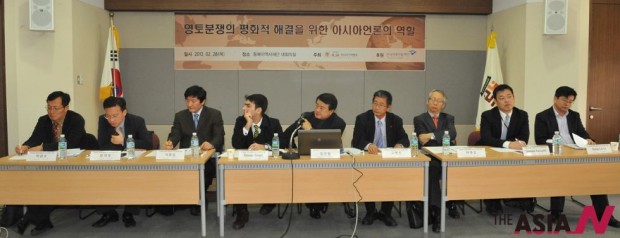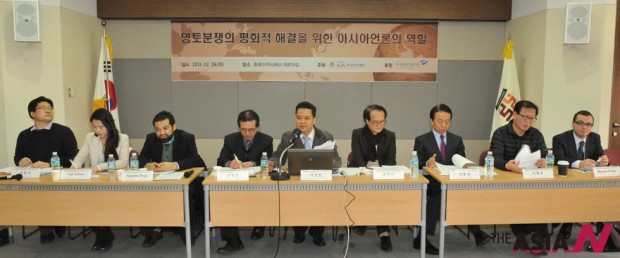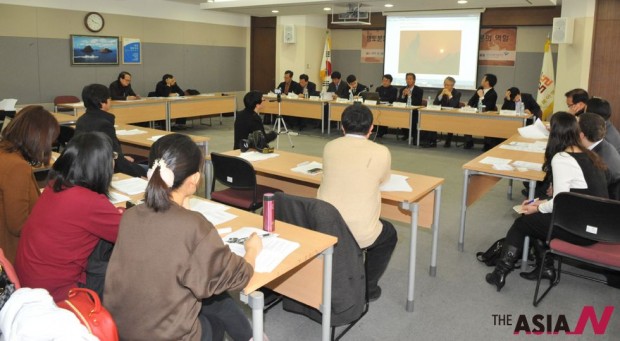How media plays in territorial disputes
Truthful and fair reporting based on the facts from an objective viewpoint might be one of the ways in which the media can help find peaceful solutions to rampant territorial disputes in Asia.
During a seminar organized by the Asia Journalist Association (AJA) and sponsored by the Korea Press Foundation (KPF), speakers and panelists put an emphasis on the media’s role for the peaceful resolution of regional security concerns. They pointed out that media outlets from involved nations need to avoid provocative wording and maintain the neutral writing of disputed region names, which would contribute to ease off the heightened conflicts.
The AJA seminar titled ‘Asian media’s role for the peaceful resolution of territorial disputes’ was held on Feb. 28 at state-run think tank, the Northeast Asian History Foundation’s conference room in Seoul, Korea amid the escalated tension on territorial issues among East Asian nations.
Journalists and media scholars from Korea, Japan, China, Turkey and Austria participated in the seminar as keynote speakers and discussants. The seminar consisted of two sections: “Comparison of Media Reports about Territorial Disputes in Asia” and “The Role of Asian Media for Peaceful Solutions to the Territorial Disputes.”
In the first session, Ko Myung-jin, Director of Yeongwol Media Journalist Museum and former President of Korea Press Photographers Association, discussed photo journalism on northeast territorial disputes in the Korean press. He demanded the need for the visual when writing reports. “Journalists often overlook the visual images in their articles, but images are very powerful and make people feel and feelings lead to action,” he added.
Huh Young-seop, a senior columnist, gave a brief view on various stances of each nation’s media outlets toward Senkaku/ Diaoyu islands and South China Sea disputes. “People often talk about ‘borderless journalism,’ but actually boundaries cannot be ignored even in seemingly fair news reports,” he said. He told that is why media in ASEAN countries assume different stands in dealing with China.
Alpago Sinasi, Turkish correspondent in Korea for Cihan News Agency reviewed Northeast Asian territorial disputes that have appeared in the Turkish media. He emphasized the importance of maintaining objectivity as he gave an example of how media heightened the tension of the territorial dispute between Turkey and Greece.
“Territorial issues are not matters where journalists should fall into nationalism,” said Sinasi. He added that although the media has its constraints, agreeing on values such as peace and human rights might be helpful.
Lee Youn Sam, adjunct professor of Sogang University Graduate School of Mass Communication, explained the Kashmir disputes by comparing the three different aspects of reporting from India’s ‘The Times of India,’ Pakistans’ ‘The News,’ and Britain’s ‘BBC.’ He concluded that BBC has relatively been close to ‘peace journalism’ by staying neutral during the dispute.
Han Yong-sup, Vice President of the Korea National Defense University, discussed East Asian territorial disputes and conflicting maritime sovereignty claims in terms of the arms race in the region. When explaining the strategic rivalry between the US and China, he pointed out that the dimension of the ROK-US alliance should be expanded to security precautions for regional disputes.
A senior journalist Yoon Jae-seok looked into the circumstances and background of issues concerning territorial disputes that continue to deepen throughout the world. He stressed the need to avoid chauvinistic journalism and agitating yellow journalism.
Michael Prieler, professor of Hallym University, said “The diplomatic fallouts and economic consequences of such disputes have a much higher price than the actual benefits these (disputed) islands could ever have.” So both parties need to “drain the emotion from the issue and bring it down to the facts.” Especially, the media should be careful not to become a mouthpiece for propaganda of politicians, main actors or interest groups.
“It might be a Utopian hope, but one solution could be for the two countries to share the two main islands and make them a symbol of peace in East Asia. The solution would gain both countries the respect of the international community and perhaps become a model that other countries could follow when facing similar disputes,” he said.
Lee Byung-hyo, Publisher of Today’s Commentary, proposed a specific solution to East Asian territorial dispute in a bargaining package deal among Korea, Japan and China. “Consulting a third eye through other media reports from those not involved may also help to get a larger picture of ongoing disputes,” he added.





























































